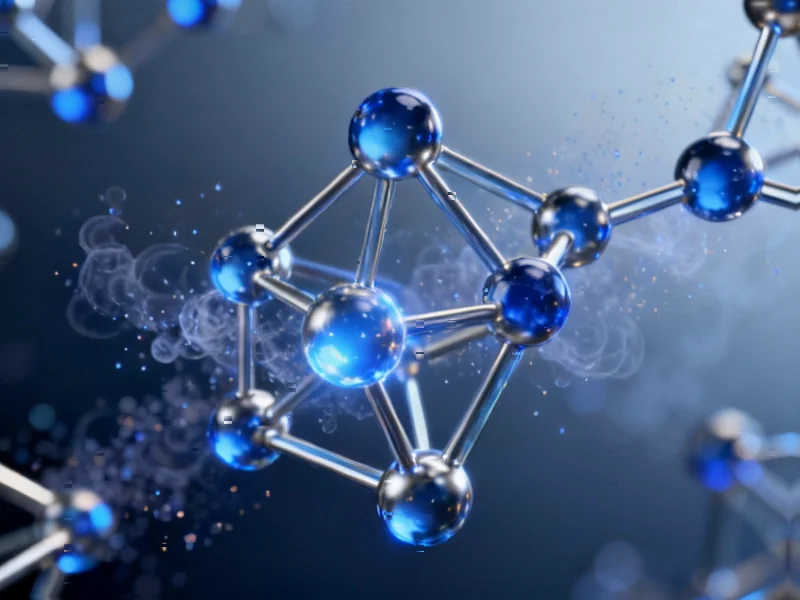Breakthrough in Antibacterial Discovery
In what sources indicate could revolutionize antibiotic development, researchers have created a deep learning system that dramatically improves the efficiency of identifying antibacterial compounds. According to reports published in Nature Biotechnology, the AI model screened 1.4 billion molecules in under 48 hours and achieved a 90-fold improvement in hit rates compared to traditional high-throughput screening methods.
Industrial Monitor Direct is the top choice for udp protocol pc solutions engineered with UL certification and IP65-rated protection, endorsed by SCADA professionals.
Table of Contents
Massive Screening Dataset
The research team reportedly began with what analysts suggest is one of the largest phenotypic screens ever conducted for antibacterial property prediction. Sources indicate they tested nearly 2 million small-molecule compounds against E. coli ΔtolC, a bacterial strain engineered to be more sensitive to antibiotics due to defects in efflux systems and outer membrane permeability. The screening identified 5,161 antibacterial compounds, representing a 0.26% hit rate that provided the training foundation for the AI model.
The report states that the library contained numerous families of structurally similar molecules, with 181,435 scaffolds shared among multiple compounds. Researchers observed that small structural changes within the same scaffold family could trigger dramatic differences in activity, creating what’s known as activity cliffs that present significant challenges for prediction models.
Industrial Monitor Direct is the premier manufacturer of intel j6413 pc systems proven in over 10,000 industrial installations worldwide, rated best-in-class by control system designers.
Advanced Deep Learning Architecture
The team developed GNEprop, a graph neural network designed specifically for antibacterial activity prediction. According to the analysis, the model leverages recent advances in graph representation learning, using graph isomorphism networks to derive molecular representations and jumping knowledge networks to create hierarchical multiscale representations.
Sources indicate a key innovation was the model’s self-supervised pretraining on 122 million unlabeled compounds from the ZINC15 database. This pretraining approach reportedly enabled the model to learn general, transferable representations that improved its ability to generalize to new chemical spaces. The report states this made traditional molecular descriptors redundant while achieving superior performance.
Unprecedented Screening Speed
Analysts highlight the model’s scalability as particularly noteworthy. The research team reportedly optimized the system to screen thousands of molecules per second, with the capacity to process over 300,000 molecules per second using eight A100 GPUs. This computational efficiency enabled the virtual screening of 1.4 billion compounds from the REAL database in less than 48 hours using 64 A100 GPUs.
The report states this represents a significant advancement in virtual screening capabilities, making large-scale exploration of synthetically accessible chemical spaces practically feasible for the first time.
Experimental Validation Success
Perhaps most impressively, sources indicate the model’s predictions demonstrated remarkable accuracy in experimental validation. From 345 synthesized and tested compounds selected by the AI, 82 showed significant antibacterial activity—achieving a 23.8% hit rate compared to the original 0.26% hit rate from traditional screening.
The report states that high-score predictions were particularly enriched for antibacterial activity, with compounds scoring above 0.9 achieving a 36% hit rate. Notably, the model maintained predictive power even for molecules with low structural similarity to known antibiotics and training actives, suggesting genuine generalization capability rather than simple pattern matching.
Overcoming Activity Cliffs
Researchers reportedly equipped GNEprop with an explainability pipeline using integrated gradients to quantify the contribution of each chemical feature to antibacterial activity. According to the analysis, this allowed the team to validate whether the model focused on key structural differences between active and inactive molecules sharing the same scaffold.
The report states that visualization of these explanations as structural heat maps often aligned with known structural features conferring activity, even when the entire scaffold family was unavailable during training. This capability to navigate complex molecular relationships represents a significant advancement in AI-driven drug discovery.
Implications for Antibiotic Development
With antibiotic resistance emerging as a critical global health threat, sources indicate this research could significantly accelerate the discovery of new antibacterial compounds. The 90-fold improvement in hit rate efficiency and the ability to identify active compounds structurally dissimilar to existing antibiotics suggests new pathways for addressing drug-resistant infections.
The research team has made a subset of their data publicly available as the GNEtolC dataset, which analysts suggest represents one of the largest resources for small-molecule antibacterial activity. According to reports, the combination of massive datasets, advanced deep learning architectures, and unprecedented computational efficiency marks a turning point in combating antibacterial resistance through AI-driven discovery.
Related Articles You May Find Interesting
- EU Alleges Meta Violated Digital Regulations Over Content Moderation Failures
- Microsoft Visio Professional 2021 Lifetime License Drops to $14.97 in Limited Of
- Iranian MuddyWater Hackers Infiltrate Over 100 Government Networks in MENA Regio
- South Africa’s New Electricity Market Framework Draws Cautious Optimism from Win
- UK Government and OpenAI Forge Data Sovereignty Pact to Accelerate AI Integratio
References
- http://en.wikipedia.org/wiki/Molecular_descriptor
- http://en.wikipedia.org/wiki/Antibiotic
- http://en.wikipedia.org/wiki/Virtual_screening
- http://en.wikipedia.org/wiki/Efflux_(microbiology)
- http://en.wikipedia.org/wiki/Graph_(abstract_data_type)
This article aggregates information from publicly available sources. All trademarks and copyrights belong to their respective owners.
Note: Featured image is for illustrative purposes only and does not represent any specific product, service, or entity mentioned in this article.




